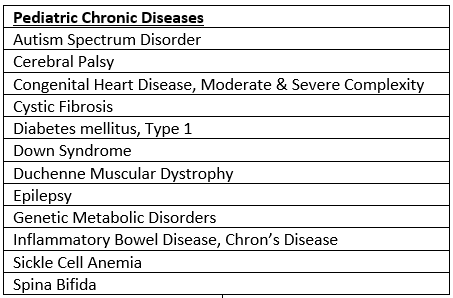Children with Chronic Conditions
Category: Abstract Submission
Children with Chronic Conditions I
135 - Healthcare Utilization Across the Lifespan for Patients with Pediatric Chronic Disease in an Integrated Healthcare System
Sunday, April 24, 2022
3:30 PM - 6:00 PM US MT
Poster Number: 135
Publication Number: 135.304
Publication Number: 135.304
RAGHUVEER PUTTAGUNTA, Geisinger Commonwealth School of Medicine, Mcallen, TX, United States; Thomas W. Davis, Janet Weis Children's Hospital at Geisinger, Danville, PA, United States

RAGHUVEER PUTTAGUNTA, MD
Clinical Informatics Fellow
Geisinger Commonwealth School of Medicine
Mcallen, Texas, United States
Presenting Author(s)
Background: Patients with pediatric chronic disease (PCD) make up over 8% of the children in the United States but utilize over 23% of healthcare services. Their care is associated with increased outpatient, emergency, and hospitalization visits, yet guidance for healthcare system planning of utilized services is limited.
Objective: To understand the evolution of healthcare services used by patients with PCD over a patient’s lifespan.
Design/Methods: Healthcare encounters documented within the medical record for a rural integrated healthcare system were categorized for patients with 12 common pediatric chronic diseases from a ten-year time span between 2010 to 2020. (Table 1) Encounters were categorized based on service location (ie inpatient, outpatient), clinical specialty including supportive services like nutritional services, and encounter type (eg hospitalizations, surgery, in-person office visits, tele video visits, patient portal messages, and telephone encounters). Tabulated data was limited to points where at least 3 unique patients were identified for each age and disease state. Differences in average encounters based on patient age, gender, disease, specialty, and encounter type were evaluated by chi-squared and multivariate logistic regression modeling in SAS 15.1.
Results: A total of 23,708 patients from age 0 to 62 years were included in the study with congenital heart, epilepsy, diabetes, inflammatory bowel, and autism being the most common diseases states. Within 1 year of diagnosis there is an independent increase in number of office visits, inpatient encounters, and non-office based encounters (patient portal and telephone message based encounters) irrespective of age at time of diagnosis, disease type, or historical time during the study period (p < 0.001). In general, disease states followed either a progressive-relapsing (eg cystic fibrosis, down syndrome) or relapsing-remitting pattern (eg diabetes, autism) when evaluating total encounters per year. Years with increased inpatient services were also associated with increased office visits and non-office based communications. The last 3 years in the study period noted an increased diversity of departments, services, and specialties across age and disease type compared to the first 3 years in the study (p < 0.001).Conclusion(s): The diversity and quantity of healthcare encounters changes based on unique patient needs, but general patterns in how services are used over the lifespan can help health system administers plan for expected care needs for those with PCD.
Table 1: Pediatric Chronic Diseases Evaluated
Objective: To understand the evolution of healthcare services used by patients with PCD over a patient’s lifespan.
Design/Methods: Healthcare encounters documented within the medical record for a rural integrated healthcare system were categorized for patients with 12 common pediatric chronic diseases from a ten-year time span between 2010 to 2020. (Table 1) Encounters were categorized based on service location (ie inpatient, outpatient), clinical specialty including supportive services like nutritional services, and encounter type (eg hospitalizations, surgery, in-person office visits, tele video visits, patient portal messages, and telephone encounters). Tabulated data was limited to points where at least 3 unique patients were identified for each age and disease state. Differences in average encounters based on patient age, gender, disease, specialty, and encounter type were evaluated by chi-squared and multivariate logistic regression modeling in SAS 15.1.
Results: A total of 23,708 patients from age 0 to 62 years were included in the study with congenital heart, epilepsy, diabetes, inflammatory bowel, and autism being the most common diseases states. Within 1 year of diagnosis there is an independent increase in number of office visits, inpatient encounters, and non-office based encounters (patient portal and telephone message based encounters) irrespective of age at time of diagnosis, disease type, or historical time during the study period (p < 0.001). In general, disease states followed either a progressive-relapsing (eg cystic fibrosis, down syndrome) or relapsing-remitting pattern (eg diabetes, autism) when evaluating total encounters per year. Years with increased inpatient services were also associated with increased office visits and non-office based communications. The last 3 years in the study period noted an increased diversity of departments, services, and specialties across age and disease type compared to the first 3 years in the study (p < 0.001).Conclusion(s): The diversity and quantity of healthcare encounters changes based on unique patient needs, but general patterns in how services are used over the lifespan can help health system administers plan for expected care needs for those with PCD.
Table 1: Pediatric Chronic Diseases Evaluated

